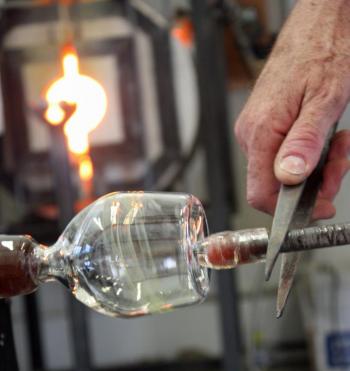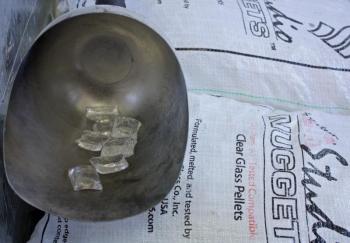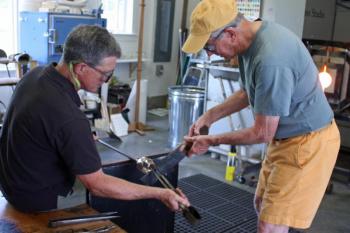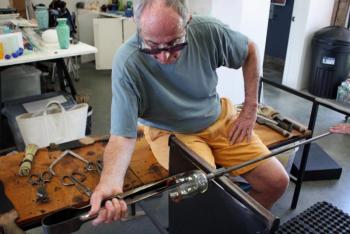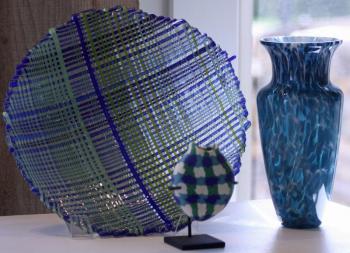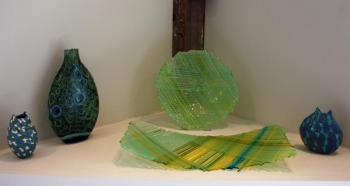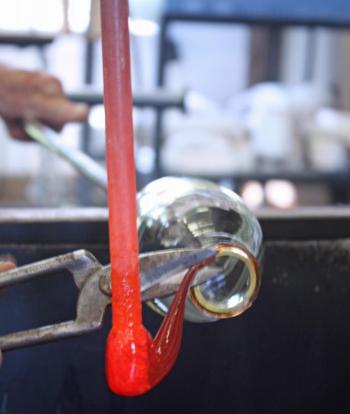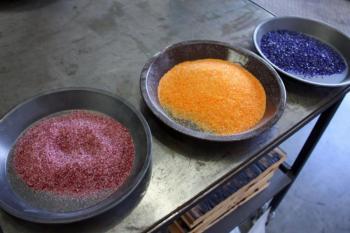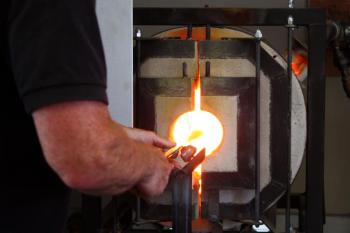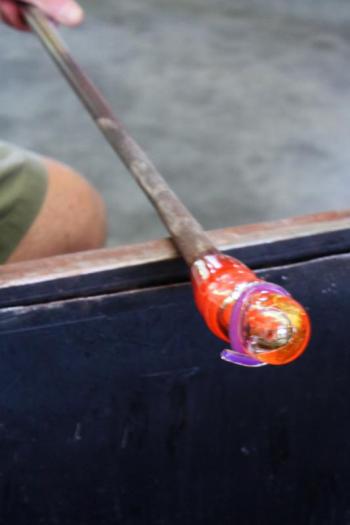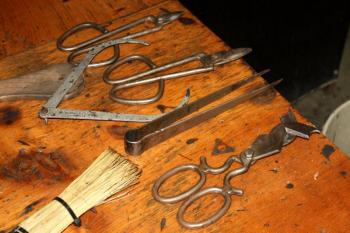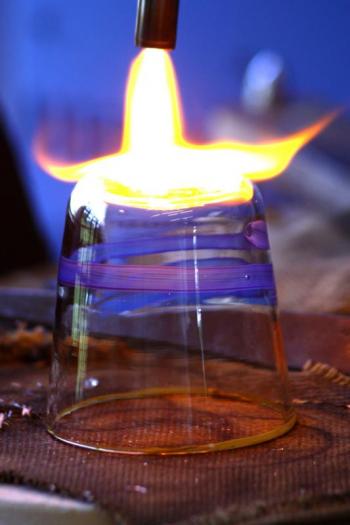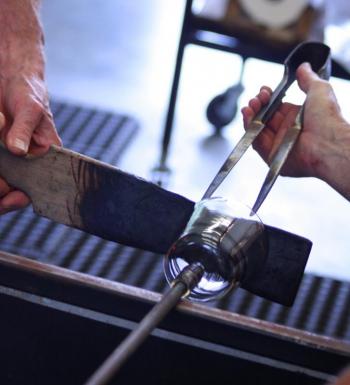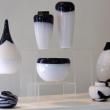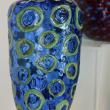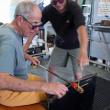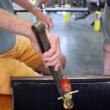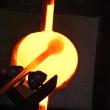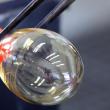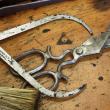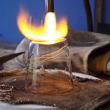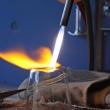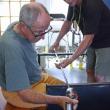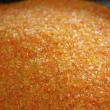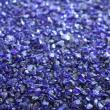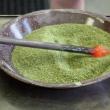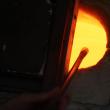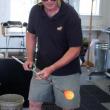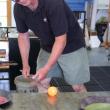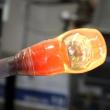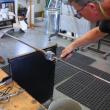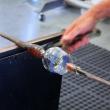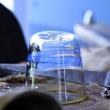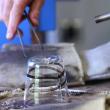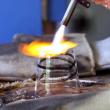Learning the dance of glass blowing with David Jacobson
MONTVILLE — Tucked down a dirt road in the western Waldo County town of Montville sits an unassuming art studio that creates one-of-a-kind hand-blown and kiln-formed glass. Run by one of the most friendly glass blowing artists a person could ever meet, David Jacobson is not only a glass artist, but also a teacher of the craft.
Watching the process of making a single drinking glass — beginning with gathering a blob of molten clear glass onto the end of a stainless steel blow pipe, rolling it on a steel table top called a marver to create a shape, blowing the first air bubble into the glass and adding more molten glass, shaping and extending the sides, blowing more to increase the size and shape, adding the lip wrap and smoothing the top of the glass and then finally disconnecting the finished product from the "punty" or steel shaping rod, and smoothing the rough glass on the bottom with a torch — took Jacobson and his partner this day, Richard Anderson, of Rockport, less than 20 minutes.
"That's one of the fun things about glass," said Jacobson. "First, it's very active, which I really like. I's very physical; but, it's all forward, there is no reverse, no time out, no 'Let's get a cup of coffee and think about this.' When you go, you go. And you're committed."
You can see how the teamwork starts to work as you watch Jacobson and his "student-of-the-day" work. And on this summer day, Anderson was helping make a set of drinking glasses he would eventually take home.
| Note: This story was originally published in the Fall 2016 edition of the WAVE magazine, produced and published by Penobscot Bay Pilot. |
"You start knowing what to do ahead of time," said Jacobson. "They call it a dance when you start working together and it really is. You don't have to do as much communicating verbally as you normally would. It gets to be a head-nod and one word or so. It's a real attractive part of the whole process."
Plus, Jacobson said, working in teams is another part of the process he enjoys.
"Working in teams is the Italian technique, the Venetian style, where you work with an assistant,” he said. “It's so much more efficient and much more fun too, it's very social.”
Jacobson first learned how to blow glass at the University of Minnesota in the 1970s. He did a "brief stint for a masters of fine arts at University of Wisconsin-Madison, for just a semester, then quit school altogether and began a career as a cartoonist.
But he said he always knew he would get back into glass-blowing and glass art. So in 1984, when he moved back to New York he said he really learned how to blow glass in Brooklyn.
"It's where [Brooklyn] they have a public access studio,” he said. “And they have teachers from all over come in there. And from there, I started at the Corning Museum Studio, and took a lot of classes with the Italian maestros. I was lucky to be able to do that.”
Jacobson said he tries to work in his studio in a team every day. There are friends and people he has met through the course of his work who want to learn, or just have time to help out, so Jacobson teaches them. And that has evolved into full-fledge workshops, inviting people into his studio to learn the art and experience the beauty of the glass-blowing dance.
"That's the exchange that I really enjoy,” he said. “In exchange for learning how to blow glass, they assist me. And it works really well. Basically, I work production about three days a week, and I have lessons almost every day, which is really great."
Jacobson said one way he keeps the stress level down when he has to go into production mode, is to not think about that he has to create 25 pieces of something.
"Instead of stressing about the 25, I tell myself I have one to make, 25 times. That way, I focus on the one I'm doing, each time," said Jacobson.
That's an important way to look at working with glass, because there is no going backward, once you start.
Although Jacobson said you can fix things to a point, but it's nearly impossible to make something smaller, if it's gotten to be too big and that' the mistake.
"Really, the whole process is you are fixing as you go. You are constantly fine tuning, making adjustments, fixing. I was told that the art of glass blowing is learning how to correct your mistakes and it truly is that," said Jacobson. "What's fun is the process is never by time. You don't go into the heat for 6 seconds or 8 seconds, it's all by feel, by the color, how it looks, how it's moving. So every piece is different that way. Either it's cooling down faster or the pressure you apply is different from one time to the next. So you are always adjusting. It's a constant and that's the beauty, and the fun."
All of these things are why, at the end of each day in his studio, Jacobson says he is never tired.
"At the end, when I finish something like we did today, six drinking glasses and we didn't lose one, I'm always exhilarated. I'm like wide awake. It's like, I'm pumped, because it's so much fun to do," he said.
His studio has become a popular attraction for those seeking an experience during their stay in Maine, and for locals, too. After spending a day in the studio with Jacobson, learning by doing, the take-home is not only the thrill of making a piece of art or a functional glass item, but being able to come back to the studio 24 hours later and take what was made home as a souvenir.
In addition to expressing his creative side in glass, Jacobson has had a long career as a cartoonist and illustrator. For 18 years he created a color, daily cartoon for Gannett newspapers. His cartoons have appeared in the New Yorker, New York Times, Washington Post and USA Today. He has also illustrated children's books, as well as greeting cards, and had a syndicated sports cartoon with United Media.
Learn more at his website, davidjacobsonglass.com.
Reach Editorial Director Holly S. Edwards at hollyedwards@penbaypilot.com and 207-706-6655.




